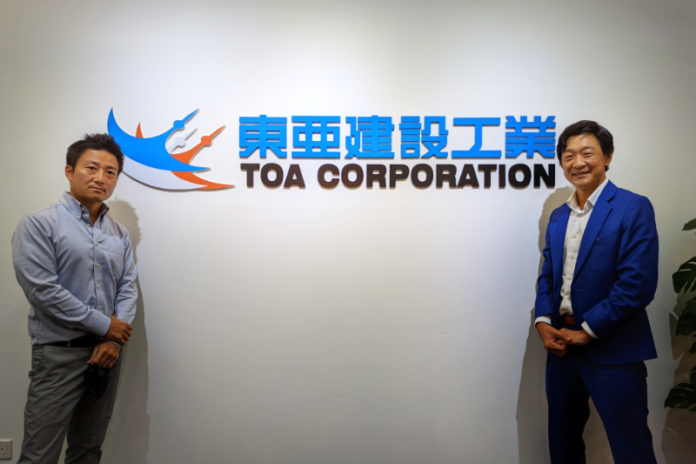Contact management company Sansan is all about digitising documents. Its main focus is scanning business cards, analysing them, and organising and tracking relationships between people via its cloud-based software.
The Tokyo-based firm claims that its optical character recognition technology – which uses artificial intelligence and machine learning – is 99% accurate. Even then, a person still manually ensures that the captured information is correct.
Sansan, however, has expanded its services to invoice management with its Bill One platform, which can help enterprises in their digital transformation. TOA Corporation, a general contractor construction company, recently partnered with Sansan to digitise its invoice management processes, which is said to involve 1,000 monthly invoices going through their finance team using a manual workflow.
Frontier Enterprise recently got in touch with Kenichi Moriyama, General Manager of Singapore at TOA Corporation, as well as Edward Senju, Regional CEO of Sansan, to discuss Bill One, the challenges in deploying it, and several other topics of interest.
Simplifying systems
According to Moriyama, the Sansan deployment helped TOA Corporation streamline its procedures.
“Now, more of the communications between us and our vendors will move into the cloud with Bill One, allowing us to automate much of our invoicing and vendor-side operations that were previously more manual and consumed substantial man hours to oversee,” he shared.
“Sansan’s Bill One helps us save costs, go paperless across more of its finance operations, and at the same time reduce the amount of overtime our finance team have to put in, resulting in better work-life balance,” Toriyama said.
He also remarked that Bill One integrates “seamlessly” with TOA Corporation’s systems, and that the ongoing support from Sansan’s customer success team has been “excellent”.
“We have been able to register a growing number of our suppliers’ finance information in the cloud with Bill One. This means we no longer have to rely on our legacy internal systems to do this,” Toriyama added.
The implementation had its challenges as well. According to Senju, these were minor and mainly involved how to ensure the Sansan platform was properly integrated with TOA Corporation’s existing systems and operations.
“In some cases, Bill One has been able to co-exist with their existing systems while in other areas it has entirely replaced their legacy systems and software,” Senju said.
“In the last scenario, it allows more processes and functionality of their finance team and invoice management across vendors to be consolidated in a single dashboard, which we see as a positive outcome,” Sansan’s Regional CEO added.
Cutting IT costs
In its partnership with Sansan, TOA Corporation realised that it’s better for them to work with an external party than develop their own IT environment.
“We developed our own in-house IT infrastructure over many years, which was constantly evolving but also costly to maintain and update,” Toriyama said.
“Ultimately, we found that existing IT solutions such as Sansan’s – which is entirely cloud-based, affordable, and secure – were able to replicate much of what we were developing ourselves with our custom IT systems,” he noted.
In the past few months, it became apparent to TOA Corporation that it made more sense to reduce their investments into their own custom IT infrastructure and instead use Sansan, which they found more cost-effective.
“As such, you could say over the years our IT systems have evolved from being heavily custom and built in-house to being more provided by technology companies that are leaders in cloud software, saving costs and taking pressure off our internal IT teams,” Toriyama added.
The main reason for TOA Corporation to digitalise their invoice system is to move away from its paper-based processes.
“As more businesses like ours look to adopt environment, social, and governance (ESG) frameworks, reducing paper wastage while improving data governance is a priority,” said Toriyama.
“In 2022, we are increasing our efforts in the ESG front and are confident that working with Sansan’s team will contribute positively towards our ESG efforts in areas like paper reduction and data custody,” he added.
Jumping into digital
Senju believes they’re particularly suitable for a company like TOA Corporation because Sansan has “deep” experience working with traditional sectors like construction, real estate, and maritime, helping with their digital transformations.
“Shipping and maritime, for example, struggled during the supply chain squeeze last year, as turnarounds at ports were delayed and strain built up in a system still largely running on outdated processes and technologies – such as paper over digital,” he observed.
“Construction and real estate, too, took a heavy hit at the height of the pandemic. Many projects and sites were partially or completely closed down for extended periods,” Senju added.
“Globally, the top players in construction agree that digital technologies are critical to their survival, according to research by McKinsey, yet many small and medium players still need to do more,” he said.
Senju’s advice to businesses ready to take the plunge but are not sure where to begin: “Start small and go fast. Identify a department or team ripe for a digital transformation pilot project and get it underway immediately.”
“Then, based on positive results, start rolling out digital initiatives across more of the organisation. Something as simple as moving a finance team’s invoice processes from predominantly paper-based to digital formats, as TOA Corporation is now doing, is an easy point of entry,” he recommended.
In the Sansan executive’s perspective, once an organisation invests in digital technologies, it often reveals benefits unseen at the onset.
These benefits, said Senju, include improved remote work capabilities, superior corporate and data governance, and even more sustainable operations with lower carbon footprints.
“Think about all the paper that digital alternatives typically save,” he mused.
















